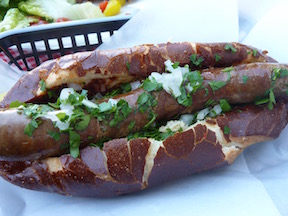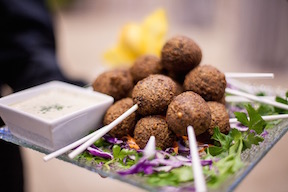Kosher and What It is Not
Kosher: What It is Not
Kosher can be so complex that sometimes its easier, a la Michelangelo, to peel away the layers of what Kosher “is not” to arrive at its true essence. It also can clear up a lot of theories that have become urban legend, along with the idea of it being bland. The images here, from Got Kosher? Restaurant and Bakery, prove owner-chef Alain Kosher’s mission to offer delicious food can “happen to be Kosher.”
Kosher is not “Kosher-style food” – “Kosher” does not refer to a style of cooking.
This label on a dish usually refers to the category of traditional Jewish fare which have come to be associated with Jewish traditions, such as blintzes and matzah ball soup, and there is no thing as “kosher style” that has the true meaning of the rules of what can be eaten. When a restaurant calls itself “kosher-style,” it usually means that the restaurant serves what are considered traditional Eastern Jewish foods, and it almost invariably means that the food is not actually kosher.
Kosher does not refer to an ethnic food. Any style of food may be kosher or non-kosher. Those that are certified kosher, select their ingredients and prepare their food in accordance with Jewish law. This can be done in any cuisine from Asian to Tunisian, with more and more exciting non-eastern European cuisines popping up, such as Got Kosher? inspired translation of international .
When something is “trayf” it means that it is not Kosher. The word comes from the word terayfa, “torn” (from the commandment not to eat meat that has been “torn” by other animals). Kosher refers to Jewish dietary laws (laws of kashrut). and the word stem from the Anglicized form of the Hebrew kasher, (literally “good” or “proper”)
Jews throughout history observed these kosher laws as an opportunity for obedience to God and for preserving Jewish unity and identity. It has also come to signify “fit for ritual use”
Kosher does not refer to a blessing. Rabbis or other religious officials do not “bless” food to make it kosher. Observant Jews recite blessings over food before eating it, but these have nothing to do with making the food kosher.
Meat and dairy dishes are not eaten within four hours of each other, and a restaurant is either a meat or a dairy restaurant. Got Kosher? uses dairy substitutes since it is a meat dining place, including their award-winning pastries.
Wine and grape products are not kosher (Gen. 1:29) But they are permissible according to kosher laws only when they are grown and prepared under Jewish supervision.
Gelatin is not kosher. Restrictions of what animals can be eaten include the flesh, organs, milk (but not together) and any by-products and only animals that chew their cud and have cloven hooves fall into the category of kosher (Lev. 11:3; Deut. 14:6). This means that pork, camel and rabbits may not be eaten. This means that gelatin is not kosher because it is usually made from horse hooves. For the same reasons, most hard cheeses are not kosher because they are processed using an enzyme or a blood-clot from the stomach lining of non-kosher animals.
Kosher is not kept by all Jews (and non Jews can keep kosher).
Orthodox Jews usually fully obey what are known as the divine laws of kashrut, in all time and places. Conservative Jews keep kosher consistently though usually with slightly less strict rules. Reform Jews usually do not keep kosher, and some Jews keeping kosher only at home. (As the old saying goes, “where there are four Jews, there are five opinions.”)
Certain parts of kosher animals are non-kosher. One such part is the sciatic nerve in the hindquarters, which is extremely difficult to remove- so for the most part only the front of the animal is eaten. Thus some of the choicest cuts of meat – like filet mignon and sirloin steak – are forbidden. The fat surrounding the animal’s organs is also trayf. And a biochemical difference does exist between the this fat and the fat surrounding the muscles (which is kosher).
Birds of prey and scavenger birds, such as eagles, hawks and vultures, are not kosher (Lev. 11:13-19; Deut. 14:11-18). Only domesticated fowl, such as chicken, turkey, quail and geese may be eaten.
No insects are kosher (Lev. 11:12 although the Torah (Laws) allows for certain exceptions, such as locusts, but since the rabbis have not been able to determine which these are, it’s easier to just put them all in the forbidden category. It also applies to the many additives and food colorings are made from insects.
There is no one way to observe kosher, even among Jews. Orthodox Jews usually only eat foods be certified kosher by a trained rabbi, (and a supervisor called a mashgiach is hired by every certified kosher restaurant to be on premise at all times). The “seal of approval” indicates a mashgiach has observed and approved the product’s preparation is called a hechsher. Most Conservative Jews who observe kosher laws are satisfied to read product ingredient labels and reform Jews follow their own instincts.
The commonly seen letter “K” on a product by itself does not mean the product is kosher. The letter does not signify kosher approval by a mashgiach, which does prove it is kosher. The manufacturer is just certifying that the product is kosher – which has been proven untrue in many cases. Also because a letter cannot be trademarked, any product can carry a “K” on its label. The letter U inside a circle, which is the certification symbol of the Union of Orthodox Jewish Congregations, means it is kosher. A P inside a circle denotes a food fit for Passover (when fermented foods are not permitted), the letter “M” to identifies a meat product, and the letter “D” is the mark for dairy.
The word “pareve” or “parve,” indicates a pareve or neutral food – which can be eaten with meat or dairy. But that’s another whole story.
www.gotkosher.com, 8914 W. Pico Blvd. (1 blk W of Robertson), Los Angeles, CA 90035, 310.858.1920




 Gerry Furth-Sides
Gerry Furth-Sides  Barbara Hansen
Barbara Hansen  Chef-owner Alain Cohen
Chef-owner Alain Cohen  Roberta Deen
Roberta Deen  Jose Martinez
Jose Martinez  Nivedita Basu
Nivedita Basu